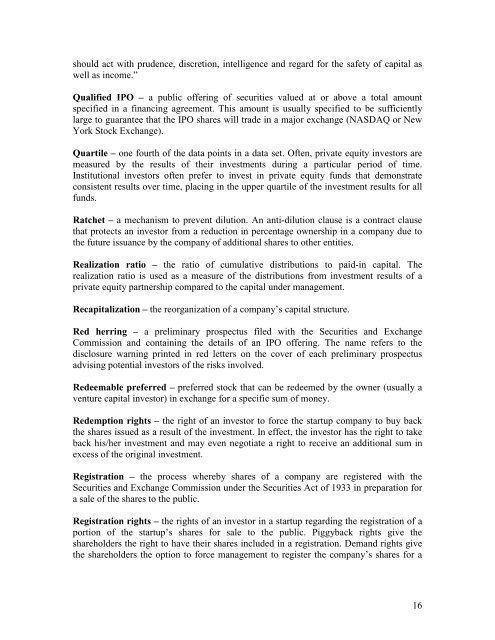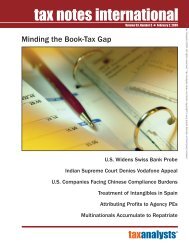Private Equity Glossary - Tuck School of Business
Private Equity Glossary - Tuck School of Business
Private Equity Glossary - Tuck School of Business
Create successful ePaper yourself
Turn your PDF publications into a flip-book with our unique Google optimized e-Paper software.
should act with prudence, discretion, intelligence and regard for the safety <strong>of</strong> capital as<br />
well as income.”<br />
Qualified IPO – a public <strong>of</strong>fering <strong>of</strong> securities valued at or above a total amount<br />
specified in a financing agreement. This amount is usually specified to be sufficiently<br />
large to guarantee that the IPO shares will trade in a major exchange (NASDAQ or New<br />
York Stock Exchange).<br />
Quartile – one fourth <strong>of</strong> the data points in a data set. Often, private equity investors are<br />
measured by the results <strong>of</strong> their investments during a particular period <strong>of</strong> time.<br />
Institutional investors <strong>of</strong>ten prefer to invest in private equity funds that demonstrate<br />
consistent results over time, placing in the upper quartile <strong>of</strong> the investment results for all<br />
funds.<br />
Ratchet – a mechanism to prevent dilution. An anti-dilution clause is a contract clause<br />
that protects an investor from a reduction in percentage ownership in a company due to<br />
the future issuance by the company <strong>of</strong> additional shares to other entities.<br />
Realization ratio – the ratio <strong>of</strong> cumulative distributions to paid-in capital. The<br />
realization ratio is used as a measure <strong>of</strong> the distributions from investment results <strong>of</strong> a<br />
private equity partnership compared to the capital under management.<br />
Recapitalization – the reorganization <strong>of</strong> a company’s capital structure.<br />
Red herring – a preliminary prospectus filed with the Securities and Exchange<br />
Commission and containing the details <strong>of</strong> an IPO <strong>of</strong>fering. The name refers to the<br />
disclosure warning printed in red letters on the cover <strong>of</strong> each preliminary prospectus<br />
advising potential investors <strong>of</strong> the risks involved.<br />
Redeemable preferred – preferred stock that can be redeemed by the owner (usually a<br />
venture capital investor) in exchange for a specific sum <strong>of</strong> money.<br />
Redemption rights – the right <strong>of</strong> an investor to force the startup company to buy back<br />
the shares issued as a result <strong>of</strong> the investment. In effect, the investor has the right to take<br />
back his/her investment and may even negotiate a right to receive an additional sum in<br />
excess <strong>of</strong> the original investment.<br />
Registration – the process whereby shares <strong>of</strong> a company are registered with the<br />
Securities and Exchange Commission under the Securities Act <strong>of</strong> 1933 in preparation for<br />
a sale <strong>of</strong> the shares to the public.<br />
Registration rights – the rights <strong>of</strong> an investor in a startup regarding the registration <strong>of</strong> a<br />
portion <strong>of</strong> the startup’s shares for sale to the public. Piggyback rights give the<br />
shareholders the right to have their shares included in a registration. Demand rights give<br />
the shareholders the option to force management to register the company’s shares for a<br />
16

















